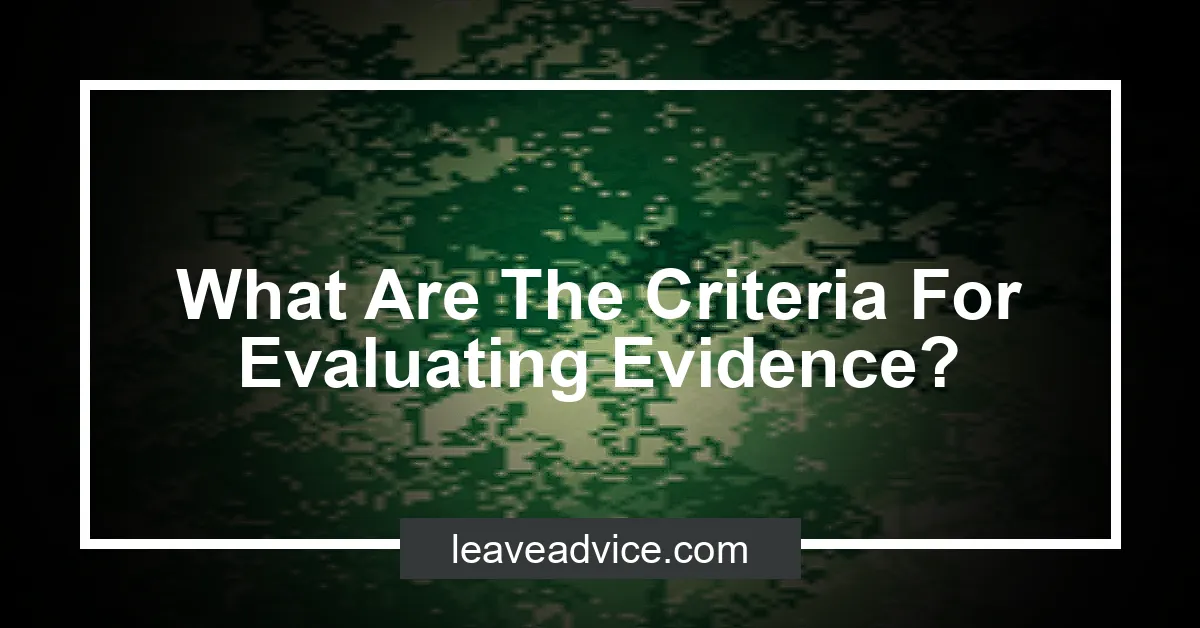What Are The Criteria For Evaluating Evidence?


Evaluating the reliability of evidence is important to determine its trustworthiness and accuracy in supporting an argument or conclusion. Reliable evidence can strengthen the validity of research findings and support informed decision-making.
The reliability of evidence refers to its consistency and dependability in providing accurate and unbiased information. In order to evaluate evidence for reliability, it is essential to consider the credibility, accuracy, and trustworthiness of the source, as well as the currency and relevance of the information.
In assessing the reliability of evidence, it is crucial to consider the context, motive, and audience of the source. Additionally, understanding the difference between reliability and validity in research can help in determining the quality and trustworthiness of the evidence.
Check out this Youtube video: “How to Evaluate Sources for Reliability – Writing for Kids” and learn the criteria for evaluating the reliability of evidence in academic writing.
Understanding the Source
Source credibility
To evaluate the credibility of a source, look for reputable publishers or recognized experts as authors. Reputable publishers like the New York Times or well-known experts in the field provide reliable sources of information.
Author’s expertise and credentials
When assessing the reliability of evidence, consider the author’s qualifications. Look for academic credentials, affiliations, or references in scholarly articles.
It’s important to verify the author’s expertise on the topic they are presenting.
Peer-reviewed sources
For trustworthy evidence, seek out peer-reviewed journals and articles. These are scholarly works that have been vetted by experts in the field, ensuring the reliability and accuracy of the information.
| Criteria for Evaluating Source Credibility |
|---|
| Reputable publishers and renowned experts |
| Author’s qualifications and academic background |
| Peer-reviewed journals and scholarly articles |
Let’s make sure to always look for credible sources, folks! After all, only the best will do!
Examining the Methodology
Research methods used
For evaluating the reliability of evidence made, it’s crucial to consider the research methods used. Quantitative research methods involve numerical data and statistical analysis, ensuring a more objective approach.
On the other hand, qualitative research methods focus on understanding behaviors and motivations, providing rich insights. The choice of research methods directly impacts the credibility and robustness of the evidence produced.
Data collection process
The data collection process plays a pivotal role in determining evidence reliability. The method of data collection, whether through observations, interviews, questionnaires, or surveys, must be meticulously planned and implemented to minimize errors and bias.
Rigorous adherence to defined steps and protocols is essential to ensure the integrity and accuracy of the collected data.
Elimination of bias
To evaluate the reliability of evidence, the elimination of bias is paramount. Researcher bias, cultural bias, or information bias can significantly impact the objectivity and trustworthiness of the evidence.
Employing measures such as self-reflection, community research before interviews, and stringent data collection techniques is imperative to minimize biases and enhance the credibility of the evidence presented.
| Research methods | Data collection process | Elimination of bias |
|---|---|---|
| Quantitative | Rigorous planning and adherence to protocols | Self-reflection and community research |
| Qualitative | Meticulous implementation of data collection methods | Stringent data collection techniques |
Let’s make evidence great again!
Consistency and Reproducibility
Need for consistent findings
Consistency in research findings is crucial as it ensures that the results are dependable and trustworthy. When findings are consistent, it fosters confidence and faith in the validity of the evidence, leading to informed decision-making and reliable conclusions.
Imagine if different studies on the same topic resulted in conflicting findings – it would create confusion and doubt, undermining the credibility of the research!
Reproducibility of results
The reproducibility of results is paramount in ensuring the reliability of evidence. If research findings cannot be reproduced consistently under similar conditions, it raises doubts about the accuracy of the initial results.
Just like a good recipe that can be cooked to taste the same each time, reproducible research results provide assurance that the evidence can be trusted and relied upon to yield similar outcomes when the experiment is repeated.
Use of multiple studies for validation
Utilizing multiple studies for validation is like cross-referencing information from different sources to confirm its accuracy. It adds strength and credibility to the evidence, reducing the likelihood of bias and errors.
Just as you would trust a product more if it received positive reviews from many satisfied customers, validation through multiple studies enhances the trustworthiness of research findings, making them more robust and dependable.
Context and Relevance
Relevance of evidence to the topic
The relevance of evidence to the topic is crucial in determining its reliability. When evaluating evidence, it’s essential to ensure that it directly pertains to the subject matter at hand.
For example, in a discussion about employee benefits, relevant evidence could include documented policies from reputable organizations or specific case studies demonstrating the impact of employee benefits on company performance.
Historical and cultural context
Understanding the historical and cultural context surrounding the evidence is imperative for comprehensive evaluation. For instance, in the realm of employee benefits, historical insights into the evolution of workplace standards and cultural shifts in employee expectations would inform the reliability of the evidence presented.
This could involve examining how labor laws and societal attitudes have influenced the development of employee benefit programs over time.
Unbiased interpretation of evidence
Achieving an unbiased interpretation of evidence is pivotal for its reliability. In the realm of employee benefits, it’s crucial to consider perspectives from diverse stakeholders, such as employees, employers, and regulatory bodies, to ensure a comprehensive, impartial evaluation.
Moreover, acknowledging and minimizing personal biases during the interpretation process is essential for arriving at substantiated and reliable conclusions.
| Criteria | Description |
|---|---|
| Relevance | Evidence aligns closely with the subject matter. |
| Historical Context | Understanding the historical development of the topic. |
| Unbiased Interpretation | Avoiding personal bias in evidence interpretation. |
These criteria collectively contribute to the assessment of evidence reliability, especially in the context of employee benefits.
It’s absolutely crucial to assess evidence within its relevant historical and cultural context while striving for an unbiased interpretation. This approach ensures a thorough and reliable evaluation, particularly in the context of employee benefits.
Scrutinizing the Data
Accuracy and precision of data
To ensure accuracy in data collection processes, it’s crucial to use reliable data resources and align key factors and parameters. For instance, in scientific experiments, choosing the right equipment, like a pipette, greatly impacts accuracy and precision, as demonstrated by the clear difference in performance among various pipettes.
Appropriate statistical analysis
Selecting the appropriate statistical methods is vital for accurate data analysis. Descriptive statistics summarize data using mean and median, while inferential statistics draw conclusions using tests like a student’s t-test.
An example is how statistical tests calculate a test statistic to describe the relationship between variables and determine a p-value.
Identification of potential manipulation
Detecting data manipulation requires keen observation and the use of statistical tests like Benford’s law. For instance, in research, editors and reviewers run multiple tests and report their averages to detect any unexpected results, which could indicate potential manipulation.
Moreover, falsification and fabrication in research data, such as changing or making up data, can lead to serious consequences.
Evaluating Bias and Conflicts of Interest
Potential bias in the research
Potential bias in research can arise from various sources, including the selection of participants, data collection methods, and data analysis. For instance, selection bias can occur if only a specific demographic is included in the study, leading to skewed results.
Moreover, publication bias may also arise if studies with positive outcomes are more likely to be published than those with neutral or negative results.
Conflicts of interest
Conflicts of interest in research can occur when researchers have financial or personal relationships that may influence their objectivity. For example, accepting payment from a company with a vested interest in the study outcomes can compromise the integrity of the research.
Similarly, using students or resources from a company in which the researcher has a financial stake can introduce bias into the findings.
Transparency in funding and support
Transparency in funding and support is crucial for maintaining the integrity of research. Providing clear disclosure of financial backers and their potential influence on the study helps to mitigate conflicts of interest.
By openly sharing grant applications, review reports, and fund allocation details, researchers can uphold the transparency essential for ensuring the reliability and trustworthiness of their work.
Expert Testimony and Opinions
Evaluation of expert qualifications
Qualifying an Expert Witness: When evaluating the reliability of evidence, it’s crucial to consider whether the expert witness has the necessary knowledge, skill, experience, training, or education. This assessment ensures that the expert possesses specialized expertise that exceeds that of the trier of fact, contributing to the credibility and trustworthiness of the evidence.
Differentiating between opinion and evidence
Expert Opinion vs. Testimonial Evidence: Distinguishing between opinion and evidence is essential.
While an expert’s testimony can aid in clarifying complex concepts and scientific evidence, it’s vital to ensure that the presented information is firmly grounded in factual evidence and expertise, avoiding speculative or subjective viewpoints.
Independent expert opinions
Independence and Impartiality: Independent expert opinions play a pivotal role in cases, emphasizing the importance of offering objective, unbiased viewpoints within the expert’s area of expertise. The duty of experts to provide independent assistance ensures the court receives reliable, impartial assessments, contributing to the integrity of the evidence presented.
Investigating Plausibility
Relationship between evidence and hypothesis
The relationship between evidence and hypothesis is crucial for evaluating reliability. When there is a strong alignment between the evidence presented and the hypothesis proposed, it enhances the credibility of the evidence.
For instance, in scientific research, if the evidence directly supports the hypothesis and is consistent with the expected outcome, it amplifies the reliability of the evidence.
Logical explanation of the evidence
A logical explanation of the evidence is a key criterion for evaluating its reliability. The evidence should be presented in a coherent and rational manner, without contradictions or inconsistencies.
By providing a clear and systematic connection between the evidence and the claims being made, it reinforces the validity and trustworthiness of the evidence. For example, in legal proceedings, a logical presentation of evidence can significantly impact the outcome of a case.
Absence of logical fallacies
Ensuring the absence of logical fallacies is essential in gauging the reliability of evidence. Logical fallacies can undermine the credibility of the evidence as they introduce flawed reasoning or deceptive arguments.
By identifying and eliminating logical fallacies, the evidence becomes more robust and persuasive, thus strengthening its reliability.
Cross-Verification and Corroboration
Cross-referencing with other sources
To ensure the reliability of evidence, cross-referencing with other sources is vital. For instance, when evaluating employee benefits, cross-referencing with renowned HR organizations like SHRM or reputable government websites such as the U. S. Department of Labor can provide a comprehensive understanding of prevailing standards and norms in the industry.
This cross-verification helps in identifying common trends and best practices, increasing the credibility of the obtained evidence.
Verification by independent parties
Independent verification solidifies the reliability of evidence. In the context of employee benefits, seeking validation from impartial entities like industry experts, legal advisors, or even consulting firms can offer diverse perspectives and prevent potential biases.
This multifaceted evaluation process validates the evidence and enhances its trustworthiness, crucial for making informed decisions regarding employee benefits.
Corroboration of evidence by different studies
Corroborating evidence through diverse studies is essential for attaining comprehensive insights. In the realm of employee benefits, referring to multiple reputable studies such as those conducted by leading HR research firms or academic institutions underscores the validity of the evidence.
This approach not only strengthens the reliability of the findings but also facilitates a well-rounded understanding of the potential impact and effectiveness of various benefit strategies.
Statistical Significance
Statistical analysis methods
Statistical analysis methods involve various techniques like predictive analysis, prescriptive analysis, exploratory data analysis, and causal analysis. These methods help in planning, designing, collecting data, and drawing meaningful interpretations from the analysis.
Significance level of findings
The significance level, known as alpha, measures the strength of evidence necessary in a sample before rejecting the null hypothesis. It determines the probability that tests will produce statistically significant results when the null hypothesis is correct.
In simple terms, it defines the threshold that the evidence needs to cross to be considered as statistically significant.
Interpretation of statistical results
Interpreting statistical results involves understanding the null hypothesis, P-values, and the concept of statistical significance. It also requires an appreciation and consideration of effect sizes, which help contextualize the statistical findings in a practical sense, aiding in better decision-making.
Remember, statistical analysis methods are like tools in a toolbox-each one serves a different purpose, and the significance level acts as the clarity filter, ensuring only the most compelling evidence makes the cut. Finally, interpreting statistical results goes beyond numbers; it’s about translating the findings into actionable insights for informed decision-making.
Exclusions and Limitations
Identification of excluded data
Identification of excluded data involves the process of managing single assets that accumulate large volumes of similar identity information for known, valid reasons.
Limitations of the evidence
The limitations of evidence-based practice are crucial to acknowledge, especially in social sciences, as evidence is never conclusive. Practitioners must make decisions based not only on current information but also on the context and variables that may influence the evidence.
Impact of limitations on the reliability
Acknowledging the limitations of the evidence is essential as it helps to identify potential sources of bias in research design, data collection, and analysis. By recognizing these limitations, the validity and reliability of the findings can be improved.
Counterarguments and Discrepancies
Respectfully acknowledge evidence or standpoints that differ from your argument. Refute the stance of opposing arguments, typically utilizing words like “although” or “however.” In the refutation, you want to show the reader why your position is more correct than the opposing idea.
Consideration of opposing viewpoints
When considering opposing viewpoints, it’s crucial to approach them with respect and objectivity. Address the differing opinion with fairness and clarity, demonstrating an understanding of the opposing argument before presenting your own stance.
By acknowledging the opposing viewpoint, you can strengthen the credibility of your own argument.
Addressing discrepancies in the evidence
Evaluating evidence involves identifying and addressing any discrepancies or inaccuracies present. Transparency is essential in dealing with these discrepancies, as it enhances the reliability of the evidence.
By openly acknowledging and rectifying discrepancies, the overall trustworthiness of the evidence is improved.
Transparency in addressing counterarguments
Transparency plays a pivotal role in addressing counterarguments. It involves honesty and openness in admitting flaws and addressing objections.
By providing transparent counterarguments, you can enhance the persuasiveness of your content, ultimately leading to a more compelling and credible presentation of your viewpoint.
| Perspective | Action |
|---|---|
| Consideration of opposing viewpoints | Approach with respect and objectivity |
| Addressing discrepancies in the evidence | Transparency and rectification |
| Transparency in addressing counterarguments | Openness and honesty in addressing objections |
By following these approaches and maintaining transparency, one can effectively handle opposing viewpoints, discrepancies in evidence, and counterarguments, ultimately strengthening the overall reliability of the argument or evidence presented.
Historical Context and Precedents
Historical significance of evidence
Historical evidence holds immense importance in understanding past events, individuals, and eras. It provides invaluable insight into the context and circumstances of historical occurrences.
For instance, primary source evidence such as diaries, documents, and newspaper accounts offer firsthand perspectives, shedding light on the prevailing social, cultural, and political realities of a particular time period.
Precedents in similar cases
The concept of precedent, or stare decisis, plays a crucial role in legal decision-making. It entails the application of established principles from previous cases to guide judgments in similar scenarios.
For instance, in common-law systems, courts often view precedents as binding or persuasive, ensuring consistency and predictability in legal outcomes.
Examining historical accuracy
Ensuring historical accuracy involves meticulous evaluation of sources to ascertain their credibility, validity, and relevance. Historians analyze the production details of sources, including when, where, and by whom they were created.
This scrutiny also encompasses an assessment of the origins and forms of the original sources, culminating in a thorough examination to gauge the accuracy and reliability of the historical evidence.
Case Studies and Examples
Real-life examples of evidence evaluation
One real-life example of evidence evaluation is the evaluation of real-world evidence (RWE) studies in the field of medicine. Real-world evidence provides clinical evidence about the usage and potential benefits or risks of medical products derived from the analysis of real-world data.
For instance, analyzing patient records and health outcomes in real-world settings can offer valuable insights into the effectiveness and safety of medical treatments.
Another real-life example is the application of community psychology in conducting pragmatic evaluations. This involves utilizing concrete examples to understand how social contexts can impact program outcomes.
By focusing on real-life scenarios within communities, researchers can effectively evaluate the impact of interventions and programs on the well-being of individuals.
Case studies of reliable evidence
A case study of reliable evidence can be seen in the practice-based evidence approach, which prioritizes the needs of decision-makers and aims to bridge the research-practice gap. By utilizing case studies to examine real-world scenarios, this approach offers in-depth insights into the effectiveness of interventions and solutions in addressing specific challenges within different contexts.
In addition, the evaluation of evidence in the form of case study methodology within qualitative research provides detailed and contextualized knowledge about specific real-world subjects. These case studies offer comprehensive insights into the characteristics, meanings, and implications of specific cases, allowing for a deeper understanding of the evidence presented.
Application of criteria to specific cases
The application of evaluation criteria to specific cases is vital in determining the credibility, accuracy, and reliability of evidence. For instance, using established criteria to assess the quality of evidence in research studies ensures that the findings are based on sound methodologies and rigorous analysis.
Moreover, the application of criteria in practice should be thoughtful and purposeful, supporting high-quality and useful evaluations. By applying evaluation criteria in a manner that encourages critical thinking and creativity, researchers can ensure that the assessment of evidence leads to meaningful and valid conclusions.
| Evaluation Criteria | Purpose |
|---|---|
| Relevance | Ensures the intervention is aligned with the right objectives and goals |
| Credibility | Validates the accuracy and trustworthiness of the evidence |
| Rigorous Methodology | Assesses the robustness and reliability of the research methodology |
| Practical Applications | Considers the real-world implications and effectiveness of the evidence |
| Contextual Understanding | Examines the contextual relevance and applicability of the evidence |
| Critical Analysis | Facilitates a thorough and critical assessment of the evidence’s strengths and weaknesses |
As seen in these examples, the criteria for evaluating the reliability of evidence play a crucial role in ensuring that evidence is credible, relevant, and applicable to real-world scenarios. Through real-life examples and case studies, the application of evaluation criteria contributes to the trustworthiness and usefulness of evidence in various fields of study and practice.
Recommended Amazon Products for Evaluating the Reliability of Evidence
Here’s a curated list of products that can help you evaluate the reliability of evidence with ease. These recommendations are based on the functionality, price, and reviews.
Magnifying Glass


A magnifying glass can help you closely examine the details of evidence, making it easier to spot any inconsistencies or inaccuracies. It is an essential tool for scrutinizing the data and verifying statistical information.
Pros and Cons
| Pros | Cons |
|---|---|
| Easy to use | Limited to visual examination |
| Inexpensive | May require good lighting |
| Portable and lightweight |
Digital Caliper


A digital caliper is useful for measuring the accuracy and precision of data, ensuring that the evidence meets the required standards. It also helps in examining plausibility by assessing the relationship between evidence and hypothesis.
Pros and Cons
| Pros | Cons |
|---|---|
| Provides precise measurements | Limited to numerical data |
| Easy to use and readout | May not be suitable for all evidence |
| Versatile for various materials |
UV Light and Blacklight Flashlight


A UV light and blacklight flashlight can reveal hidden details on certain materials, aiding in the cross-verification and corroboration of evidence by different studies or sources.
Pros and Cons
| Pros | Cons |
|---|---|
| Detects hidden features | Limited to specific materials |
| Portable and easy to carry | May not be applicable in all cases |
| Versatile applications |
Body Camera


A body camera can provide transparency and accuracy in documenting evidence collection and interviews. It helps in ensuring the unbiased interpretation of evidence and can be a valuable tool for capturing expert testimony and opinions.
Pros and Cons
| Pros | Cons |
|---|---|
| Records evidence in real-time | Limited to specific use cases |
| Enhances transparency | Requires proper handling |
| Provides audio and video evidence |
Scientific Calculator


A scientific calculator is essential for evaluating statistical significance and interpreting the statistical results of evidence. It aids in examining the methodology by verifying the significance level of findings.
Pros and Cons
| Pros | Cons |
|---|---|
| Performs complex calculations | Limited to numerical analysis |
| Suitable for statistical analysis | May not be applicable in all cases |
| Versatile functions |
Top Recommended Product for Evaluating the Reliability of Evidence
If you’re looking for the best solution for evaluating the reliability of evidence, we highly recommend the Magnifying Glass (https://www.amazon.com/s?k=magnifying+glass).


Ready to improve your evidence evaluation? Check out the Magnifying Glass today for the best results!
Conclusion
When evaluating the reliability of evidence, it is important to consider the credibility of the source. This means assessing the expertise, reputation, and bias of the individual or organization presenting the evidence.
Additionally, the timeliness of the evidence is crucial in determining its reliability, as outdated information may no longer be accurate or relevant.
Furthermore, the methodology used to gather the evidence should be scrutinized in order to assess its reliability. This involves examining whether the research methods were sound, the sample size was representative, and the data collection was rigorous.
Moreover, the consistency of the evidence with other reputable sources should also be taken into account, as this can further establish its reliability.
Lastly, the relevance and significance of the evidence in relation to the topic or issue at hand should be considered. It is important to evaluate whether the evidence directly addresses the specific question or problem, and if it provides meaningful insights or support for the argument.
This ensures that the evidence is not only reliable, but also valuable in contributing to the overall understanding of the subject matter.




